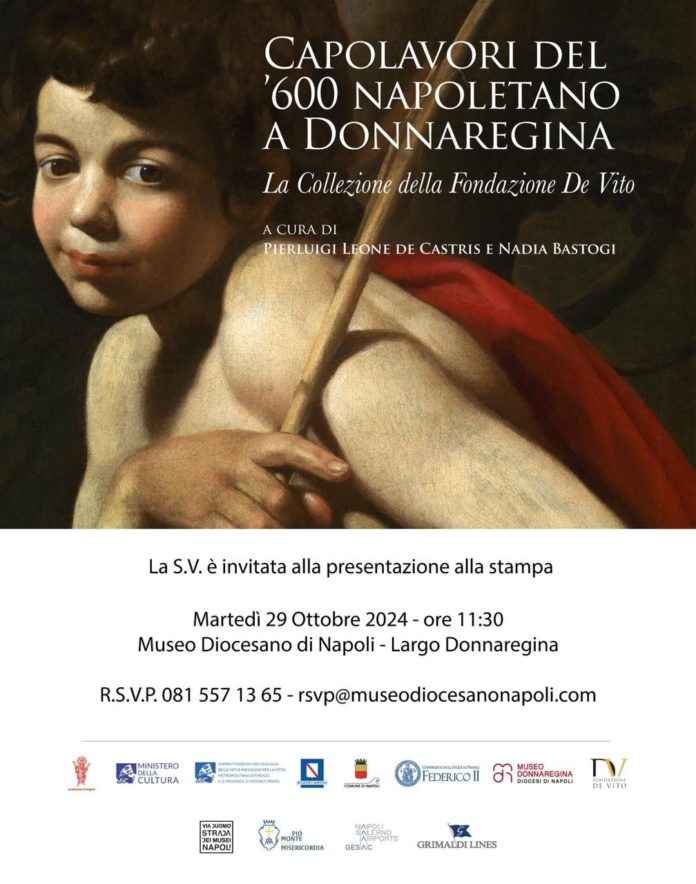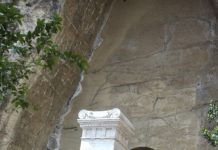La luce del Seicento, da Battistello a Luca Giordano. Per la prima volta a Napoli la raccolta di Giuseppe De Vito (Portici 1924 – Firenze 2015), grande collezionista e studioso di pittura napoletana del Seicento, a conservata nella villa di Olmo a Vaglia, a Firenze, sede della Fondazione Giuseppe e Margaret De Vito per la Storia dell’Arte Moderna a Napoli, da lui costituita nel 2011 con lo scopo di promuovere gli studi su questo periodo artistico.
Sarà presentata martedì 29 ottobre (opening alle 11,30) al Museo Diocesano di Donnaregina. Già esposti con grande successo nel 2023 nei musei francesi di Digione e di Aix-en- Provence, i dipinti di questa esposizione curata da Pierluigi Leone de Castris e da Nadia Bastogi, direttrice scientifica della Fondazione De Vito, propongono uno straordinario percorso cronologico e tematico nel secolo d’oro della pittura napoletana attraverso opere significative dei maggiori artisti, dagli esordi del naturalismo caravaggesco alla svolta barocca della seconda metà del secolo, in una sorta di colloquio ideale coi dipinti del Seicento napoletano presenti nel Museo e nella chiesa di Donnaregina.
Tra i 35 capolavori, le tele di Battistello Caracciolo, Paolo Finoglio, Massimo Stanzione, Jusepe de Ribera, del misterioso Maestro degli Annunci ai pastori, di Bernardo Cavallino, Antonio De Bellis, Aniello Falcone, Andrea Vaccaro, Domenico Gargiulo, Francesco Fracanzano, Mattia Preti e Luca Giordano, insieme a quelle dei maggiori specialisti di natura morta, come Luca Forte, Paolo Porpora, Giuseppe Recco o Giovanni Battista Ruoppolo.
La collezione (dominata da temi sacri) viene svelata a cent’anni dalla nascita di Giuseppe De Vito e insieme a quarant’anni dalla scomparsa di Raffaello Causa – grande amico di De Vito e grande studioso del Seicento napoletano – e dall’apertura della mostra da lui voluta sulla Civiltà del Seicento a Napoli.
L’obiettivo del Museo Diocesano è di intrecciare la spiritualità con l’arte e la cultura in occasione del secondo Giubileo di Papa Francesco.
17th century masterpieces in Donnaregina/ For the first time in Naples, the collection of Giuseppe De Vito, between Luca Giordano and Giuseppe Recco
The light of the 17th century, from Battistello to Luca Giordano. For the first time in Naples, the collection of Giuseppe De Vito (Portici 1924 – Florence 2015), a great collector and scholar of 17th-century Neapolitan painting, housed in the Villa Olmo a Vaglia in Florence, the seat of the Giuseppe and Margaret De Vito Foundation for the History of Modern Art in Naples, which he founded in 2011 with the aim of promoting studies on this artistic period.
It will be presented at the Museo Diocesano di Donnaregina on Tuesday 29 October (opening at 11.30 a.m.). The paintings in this exhibition, curated by Pierluigi Leone de Castris and Nadia Bastogi, scientific director of the Fondazione De Vito, have already been exhibited with great success in the French museums of Dijon and Aix-en-Provence, offer an extraordinary chronological and thematic journey through the golden age of Neapolitan painting, through important works by major artists, from the beginnings of Caravaggio’s naturalism to the Baroque turn of the second half of the century, in a kind of ideal dialogue with the Neapolitan paintings of the 17th century in the Museum and in the Church of Donnaregina.
Among the 35 masterpieces are paintings by Battistello Caracciolo, Paolo Finoglio, Massimo Stanzione, Jusepe de Ribera, the mysterious Master of the Annunciations to the Shepherds, Bernardo Cavallino, Antonio De Bellis, Aniello Falcone, Aniello Falcone, Andrea Vaccaro, Domenico Gargiulo, Francesco Fracanzano, Mattia Preti and Luca Giordano, as well as the greatest still life painters such as Luca Forte, Paolo Porpora, Giuseppe Recco and Giovanni Battista Ruoppolo.
The collection (dominated by sacred subjects) is being unveiled one hundred years after the birth of Giuseppe De Vito and forty years after the death of Raffaello Causa – a great friend of De Vito and a great scholar of the Neapolitan 17th century – and the opening of the exhibition he wanted on the 17th century in Naples.
The aim of the Diocesan Museum is to combine spirituality with art and culture on the occasion of the Second Jubilee of Pope Francis.










